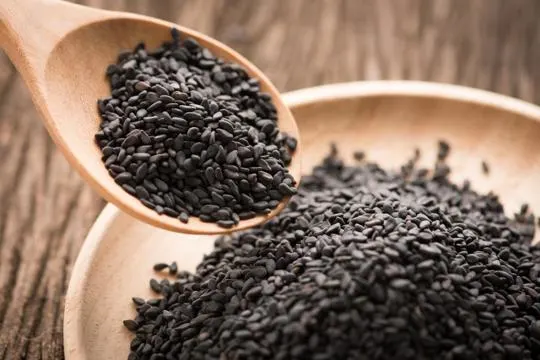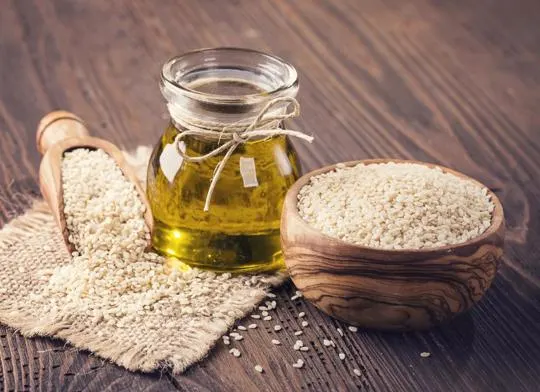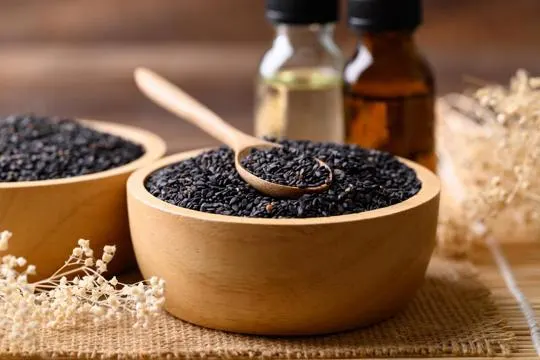Summary of key points
The main difference between black and white sesame seeds is in their appearance and level of processing. Black sesame seeds are the unhulled version of the seed, while white sesame seeds have been hulled and are often polished to give them a brighter color.
In terms of flavor, both types of sesame seeds have a nutty taste but black sesame seeds tend to have a stronger, more bitter flavor due to the hull still intact. White sesame seeds have a milder taste and are often used in baking or as a garnish for dishes.
Both types of sesame seeds are rich in nutrients such as protein, healthy fats, and minerals like calcium and iron. They can be used interchangeably in cooking but may differ slightly in appearance and taste.
Ever noticed those tiny seeds on your burger bun? Yep, sesame seeds. They’re not just for looks.
Black and white sesame seeds differ not just in color. We’re talking flavor town and nutrient city.
In our kitchens, we’ve had some epic fails and triumphs with these seeds. Black ones pack a punch, offering a bold taste. White seeds? They’re the smooth operators, subtle and nutty.
Each type transforms a dish in its own unique way. We’ve learned that the hard way. Trust us, there’s a tale or two there.
Ready for a seed showdown?
What are Black Sesame Seeds?

Black sesame seeds are a flavorful ingredient that has been a staple in a variety of cuisines for many centuries, particularly in Asian cooking.
They are also a great source of nutrients such as calcium, protein, iron, and magnesium.
These seeds have a distinct aroma and nutty flavor that is more intense and rich than their white counterparts.
They are usually slightly smaller and darker than regular sesame seeds, with a deep black or dark brown color.
Because they are so small, they are often used as a garnish or seasoning, adding a pop of color and flavor to dishes like sushi, buns, and bread.
Additionally, black sesame seeds are used in many traditional medicines and beauty products, owing to their numerous health benefits, such as promoting good digestion, reducing inflammation, and boosting skin health.
What are White Sesame Seeds?

White sesame seeds are small and oval-shaped.
They have a creamy white color and a nutty flavor.
People around the world use them in various cuisines, for the crunchy texture and taste.
As a garnish or to add crunchiness, these seeds are often used.
They are rich in vitamins, minerals, and antioxidants.
Omega-6 fatty acids and fiber are also found in them.
Plus, calcium, iron, and zinc are present, for strong bones and overall health.
For both sweet and savory dishes, white sesame seeds can be used.
Salads, stir-fries, baked goods, and desserts are some examples.
Health benefits come with these nutritious seeds.
Heart health, reduced inflammation, and better brain function are linked to them.
For an easy nutrient-boost, add white sesame seeds to your diet.
Storage-wise, they last a long time when kept properly.
An airtight container in a cool and dark spot will do the trick.
So, go ahead and sprinkle them on your favorite dishes – enjoy the taste and benefits.
Differences Between Black Sesame Seeds and White Sesame Seeds

Black sesame seeds and white – they look similar, yet they have distinct differences.
Color and Appearance
Sesame seeds come in two varieties – black and white.
The black ones have a dark, charcoal-like hue, while the white ones are pale and ivory-colored.
This contrast makes them easily visible and adds to the overall presentation.
Black sesame seeds boast an intense color, which grabs attention.
They can be used as a topping or garnish and adds depth and richness to dishes.
However, white sesame seeds have a more delicate and understated look.
They blend into recipes without overpowering the visual harmony.
The difference between the two also lies in their flavor.
Black sesame seeds have a nuttier taste, making them great for desserts like black sesame ice cream.
White sesame seeds have a milder flavor that can be used in tahini sauces or bread crusts.
Flavor and Aroma
Black and white sesame seeds have distinct flavors and aromas.
The black ones have a nuttier, stronger taste.
The white ones are milder.
Black sesame seeds have a more intense aroma, while whites have a subtle, delicate scent.
Each seed variety is unique and great for different recipes.
Nutritionally, black sesame seeds have higher antioxidants.
White sesame seeds have more calcium.
Both offer iron, magnesium, zinc, and fiber.
For cooking, it’s all about flavor preference and the dish.
Black sesame seeds are used in Asian dishes like stir-fries and desserts.
White sesame seeds go in savory and sweet recipes like salads or tahini paste.
Store sesame seeds in an airtight container away from light and moisture to keep them fresh and flavorful.
Enjoy the taste and visual appeal of these tiny but mighty seeds.
Nutritional Composition
Black sesame seeds and white sesame seeds have different nutritional compositions.
Black seeds are higher in calories and fat compared to white seeds.
However, both offer lots of protein, fiber, vitamins and minerals.
Both types of sesame seeds are good protein sources – they contain all essential amino acids, making them great for vegetarians and vegans.
Plus, they are high in fiber, which helps with digestion and weight.
When it comes to vitamins and minerals, black sesame seeds stand out with their higher iron and calcium content.
Iron is important for red blood cell production, while calcium is key for strong bones and teeth.
Both kinds of seeds also contain lignans – beneficial antioxidants which are linked to various health benefits, like reducing inflammation, promoting heart health and cancer protection.
Culinary Uses and Applications
Black and white sesame seeds may look similar, but they have different uses in cooking.
Their flavor and texture add something extra to dishes.
Black sesame seeds are popular in Chinese and Japanese cuisine.
Their bold nuttiness adds flavor to stir-fries, sushi rolls, and noodle dishes.
They can also be made into black sesame paste or tahini, which is a spread or filling for desserts like mochi or pastries.
Sprinkling them on breads and cakes is also common.
White sesame seeds are common in Western dishes.
They have a milder taste that works with both sweet and savory recipes.
Toasting them first brings out their nutty flavor.
They can be used on salads, roasted veggies, and baked goods.
White sesame seeds can also be processed into tahini, a creamy paste used in Middle Eastern dips and sauces.
Both types of sesame seeds have health benefits.
They are full of minerals like calcium, magnesium, iron, and zinc.
They also contain healthy fats and fiber, which lower cholesterol and aid digestion.
Similarities Between Black Sesame Seeds and White Sesame Seeds

Black sesame and white sesame have many things in common.
Both come from the same plant, Sesamum indicum.
They also have a nutty flavor and can be used in many recipes.
As a garnish, topping, or in a paste, both types of sesame have great culinary potential.
Plus, they offer plenty of health benefits.
Such as, supporting heart health, aiding digestion, and increasing nutrient absorption.
Therefore, these seeds are a valuable addition to any diet.
Health Benefits of Black Sesame Seeds and White Sesame Seeds
Black sesame seeds boast antioxidant levels, which can help protect the body from oxidative stress and reduce chances of chronic diseases.
Plus, these tiny black seeds are great sources of fiber.
White sesame seeds, meanwhile, are packed with essential minerals such as calcium and magnesium.
Both black and white sesame seeds make amazing additions to your diet.
Sprinkle them on salads, add to smoothies, bake goods, or top off stir-fries or sushi rolls.
However, before making major changes to your diet, it’s important to consult with a healthcare professional or registered dietitian.
Where to Buy Black Sesame Seeds and White Sesame Seeds?
Do you want black sesame seeds or white sesame seeds? No worries.
They can be found both online and offline.
For starters, check out local grocery stores or supermarkets.
They likely have a range of seeds, including black and white sesame.
Look in the baking or spice aisle.
Also, shop online.
Websites specialize in selling culinary ingredients and have a wide selection of quality products.
Have the seeds delivered to your house.
Health food stores or specialty stores may carry black and white sesame seeds too.
They emphasize organic or natural products, so get the best quality.
When buying, check the freshness and packaging.
Make sure it’s secure and sealed to keep the flavor and aroma.
In conclusion, many options exist for purchasing black and white sesame seeds.
Try grocery stores, online sites, and health food or specialty stores.
Enjoy experimenting with these nutritious and flavorful seeds.
Conclusion
All in all, sesame seeds have been used for centuries around the world and are one of nature’s nutritionally-dense superfoods.
They are naturally gluten-free, rich in fiber, minerals, antioxidants and healthy fats which can help reduce inflammation and improve heart health.
The black variety has a more intense flavor than white sesame seeds and can be used to give dishes an extra flavorful kick.
Whether you decide on white or black sesame seeds, both varieties have several health benefits that should not be overlooked.
For those looking to add a bit of crunchiness to their culinary creations, sesame seeds are an excellent choice.
Whatever your preference may be, now that we know the difference between white and black sesame seeds you can make an educated decision as to which type best suits your needs.

Leave a comment